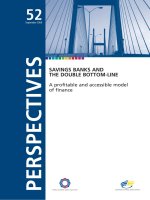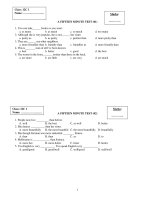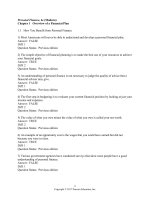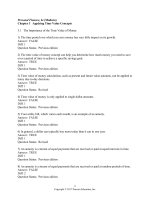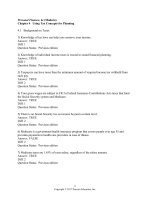Q a schweser self test 02 behavorial finance question
Bạn đang xem bản rút gọn của tài liệu. Xem và tải ngay bản đầy đủ của tài liệu tại đây (148.42 KB, 3 trang )
Use the following information for Questions 1 through 6.
Frank Brooks and Peter Timmons are portfolio managers for the largest mutual fund of Liberty
Financial Advisers, which provides a variety of mutual funds for both individuals and institutions.
Brooks has been a portfolio manager for eight years and has seen both bull and bear markets.
Timmons is his assistant and has been at Liberty Financial Advisers for the two years following
his graduation from a prestigious Master of Science in Finance program.
In their discussion over lunch, Brooks and Timmons discuss the latest quarterly earnings
announcements for several firms in their portfolio. Despite optimistic projections for some firms,
most announcements were quite disappointing. Timmons states that he is not convinced that
their prospects are as grim as the announcements suggest.
The next day, Brooks and Timmons provide a presentation to Liberty Financial Advisers' clients.
Their guest presenter is Stephen Davis, an economist at the local university who frequently
provides economic commentary for national media outlets. During his presentation, Davis states
that it is likely the United States will enter a recession next year. He recommends that the clients
shift their assets into investment grade bonds and noncyclical stocks. He states that he has been
successful in predicting recessions over the past 15 years and is certain of his forecasts. He
states further that the only time he has been wrong in predicting the business cycle is when
Congress unexpectedly increased spending beyond that expected. He states that if that had not
happened, his prediction of a mild recession would have been correct, instead of the mild
expansion that actually occurred.
During the afternoon session, Brooks discusses the various strategies at Liberty Financial
Advisers. In the value/neglected firm strategy, Liberty Financial Advisers seeks out firms trading
at reasonable valuations with no analyst following. Brooks states that several academic studies
showed these firms to be good investments over a 3-year time horizon from July in year t = 0 to
June 30 of year t =+3, following their identification on June 30 of year t = 0. Brooks states that he
has adopted this strategy for his portfolio.
Later that evening at dinner, Brooks, Timmons, and Davis discuss the day's events. Commenting
on investment strategies, Davis states that he focuses on growth stocks with 6-quarter earnings
growth and monitors his portfolio on a quarterly basis. Davis also states that when the short-term
moving average rises above the long-term moving average, this signals an opportune time to
trade.
..........................................................................................................................................................
Question #1 of 6
Which of the following best describes Timmons's behavioral characteristic? Timmons:
A) uses frame dependence.
B) uses anchoring.
C) is loss averse.because his beliefs about the firms are anchored in his previous optimistic
forecasts.
Question #2 of 6
Which of the following best describes Davis's behavioral characteristic? Davis:
A) uses frame dependence.
B) is overconfident.
C) is loss averse.
Question #3 of 6
Which of the following most likely explains Davis's behavioral characteristic? Davis:
A) uses a bottoms-up approach to assess his skills.
B) is susceptible to cognitive dissonance.
C) is susceptible to feelings of regret.
Question #4 of 6
Which of the following best explains Davis's defense of his past inaccurate forecast? Davis is
exhibiting the behavioral bias of:
A) self attribution.
B) representativeness.
C) illusion of knowledge.
Question #5 of 6
Which of the following best describes Brooks's investment strategy regarding value/neglected
firms? Brooks's strategy is based on a:
A) support level.
B) moving average.
C) resistance level.
Question #6 of 6
Which of the following best describes the trading signal indicated by Davis's investment strategy?
Davis is describing a:
A) resistance level in which the stock is thought to be overvalued, eventually reverting back to its
mean.
B) moving average where the short-term moving average is above the long-term moving
average, indicating a "buy" signal.
C) moving average where the short-term moving average is above the long-term moving
average, indicating the stock is overvalued, and the investor should sell.

